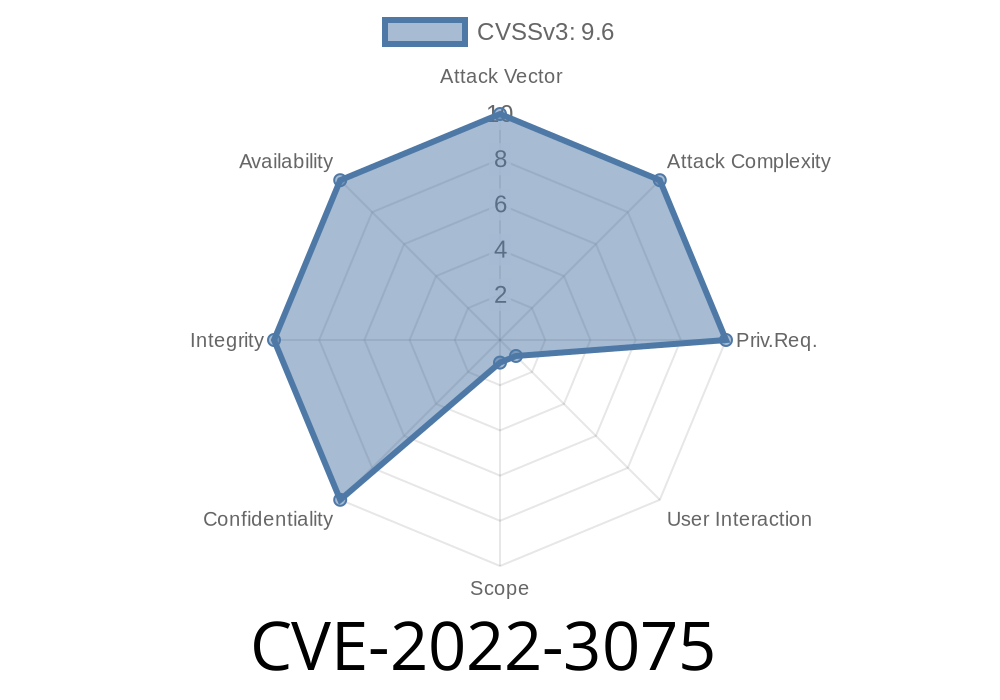CVE-2022-3075 is a security vulnerability in Google Chrome that involves insufficient data validation in the Mojo rendering engine. In simple terms, this flaw allows a remote attacker who has already compromised the renderer process in Chrome to potentially break out of the sandbox and execute arbitrary code on the target system. Google has patched this vulnerability in Chrome 105..5195.102 and users are advised to update their browsers immediately. This blog post aims to dig deeper into this vulnerability including explanation of the exploit mechanism, code snippets showcasing the flaw, and external references to the original sources.
Background
Google Chrome utilizes multiple layers of security to protect against attacks, and one such layer is the sandbox. The sandbox isolates potentially unsafe content, like the rendering of HTML pages, from the rest of the system. This isolation minimizes the potential impact of a successful exploit in the renderer.
However, Chrome's sandbox was found to have a weakness in its implementation that allows a sophisticated attacker to escape it. This vulnerability, assigned as CVE-2022-3075, is due to insufficient validation of data within Chrome’s Mojo rendering engine.
Exploit Mechanism
The exploit hinges on a remote attacker first compromising the Chrome renderer process. This can be achieved using a variety of techniques, such as exploiting a separate renderer vulnerability or tricking the user into visiting a specially crafted malicious HTML page.
Once the renderer process is compromised, the attacker can potentially exploit CVE-2022-3075 to escape the sandbox. The vulnerability exists because the Mojo engine does not properly validate certain data received from the renderer process. By forging this data, the attacker can cause Chrome to execute arbitrary code in the context of the user who is currently running the affected instance of the browser.
To better understand the vulnerability, let's examine a simplified example illustrating the problem
// Simplified example, not actual code from Chrome
int mojo_receive_data(void* data, size_t data_size) {
MojoData* mojo_data = (MojoData*) data;
if (data_size < sizeof(MojoData)) {
// Not enough data provided
return -1;
}
// ... More validation and processing of mojo_data ...
int result = mojo_process_data(mojo_data);
return result;
}
This simplified example demonstrates the function mojo_receive_data which is responsible for processing incoming data in the Mojo engine. As you can see, initially there's a check of the data_size to make sure it's at least the size of the MojoData structure. However, there are no further validations of the mojo_data itself.
An attacker could potentially craft and inject malicious data with incorrect or out-of-bounds values in mojo_data, bypassing the check, and causing the mojo_process_data function to execute code with unexpected behavior or even overwrite memory, leading to the exploit.
Original References and Patch Details
* Google Chrome Releases Announcement: https://chromereleases.googleblog.com/2023/02/stable-channel-update-for-desktop.html
* Google Chrome Security Update Details: https://chromium.googlesource.com/chromium/src/+log/105..5176.102..105..5195.102?pretty=fuller&n=10000
The patch for this vulnerability can be found in the above-linked Google Chrome Security Update Details. Chrome version 105..5195.102 includes the fix for CVE-2022-3075.
Conclusion
CVE-2022-3075 is a serious vulnerability in Google Chrome that allows a remote attacker to potentially perform a sandbox escape, further compromising the target system. Users should update their browsers to version 105..5195.102 or later to ensure they're protected against this threat. Additionally, it's important for users to remain vigilant regarding the websites they visit and to regularly apply security updates to their systems in order to best defend against potential threats.
Timeline
Published on: 09/26/2022 16:15:00 UTC
Last modified on: 10/27/2022 19:54:00 UTC
